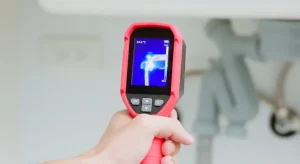
If usage has not changed but your high water bill keeps rising, a hidden leak may be to blame. Greenstar finds and repairs leaks using non-invasive tools.

Septic tanks are underground wastewater treatment systems that are commonly used in areas without access to a centralised sewage system. They're designed to treat and dispose of household wastewater in a safe and environmentally friendly manner.
Septic tanks were once the most common waste treatment systems around, but they were gradually replaced by centralised sewage systems in the mid-1800s. Today, septic tanks are mostly found in rural or remote areas, mobile home parks, and construction sites.
If you've ever used or worked with a septic tank, or if you've got one installed on your own property, you might have wondered how they actually get the job done. Well, that's exactly what we're here to explore today!
At Greenstar, we've been working on septic tanks of all shapes, sizes, and complexities for over 30 years. Check out our step-by-step guide below to find out how exactly septic tanks work!
A septic tank is connected to a property by a series of pipes. When a toilet, sink, shower, or other drain is used, the wastewater flows down the pipes and into the tank.
When wastewater enters the septic tank, it settles into three layers: solid particles (sludge), oils and grease, and clarified liquid (effluent). The sludge settles to the bottom of the tank while oils and grease float to the top, forming a scum layer. Effluent makes up the middle layer.
The beneficial bacteria in the septic tank's environment break down the organic solids in the sludge and scum layers. This biological process partially treats the wastewater, reducing its organic content.
As new wastewater flows into the septic tank, the treated effluent from the middle layer is drained into a drainfield (also called a leach field or absorption field)… A drainfield is made up of a network of perforated pipes or chambers buried in the soil.
The effluent that enters the drainfield is further treated as it seeps through the soil. The soil acts as a natural filter, removing any remaining impurities and pathogens from the effluent as it moves through the ground.
Finally, the soil's natural processes filter and remove impurities from the effluent, making it safe to return to the groundwater or surface water. The soil also disperses the wastewater, preventing it from accumulating and contaminating the groundwater.
We hope the guide above has given you a better grasp of how septic tanks can safely manage wastewater on your property.
If you've been thinking about having a septic tank installed on your own property, we're here to help! Our team of experts are well-prepared to design and set up a reliable septic tank system for your property, no matter its size or layout. We're proud of our commitment to delivering first-rate service and quality workmanship and will make the process easy by handling every aspect of the installation – from planning and supply to the actual fitting and system checks.
And that's not all – we also offer septic tank emptying services! Whether your system needs a simple purge or is suffering from a major blockage, you can rely on us to efficiently empty your septic tank and make sure the waste is properly disposed of.
Don't hesitate to request a quote online or give us a call on 01202 355 344 today. We're looking forward to hearing from you!

Recent Posts

If usage has not changed but your high water bill keeps rising, a hidden leak may be to blame. Greenstar finds and repairs leaks using non-invasive tools.

Protect your home from water leaks with 7 simple maintenance tips. Insulate pipes, inspect your roof, and install leak detectors to save money on repairs.

UK landlord responsibilities include plumbing, heating, hot water, ventilation and electrical upkeep. Prevent leaks and AC issues with regular servicing.




